[English] 日本語
 Yorodumi
Yorodumi- PDB-5tqq: Cryo-electron microscopy structure of a bovine CLC-K chloride cha... -
+ Open data
Open data
- Basic information
Basic information
| Entry | Database: PDB / ID: 5tqq | |||||||||
|---|---|---|---|---|---|---|---|---|---|---|
| Title | Cryo-electron microscopy structure of a bovine CLC-K chloride channel, main (class 1) conformation | |||||||||
 Components Components |
| |||||||||
 Keywords Keywords | TRANSPORT PROTEIN / CLC / chloride channel / membrane / kidney | |||||||||
| Function / homology |  Function and homology information Function and homology informationStimuli-sensing channels / voltage-gated chloride channel activity / chloride transport / chloride channel complex / basolateral plasma membrane / metal ion binding / plasma membrane Similarity search - Function | |||||||||
| Biological species |   | |||||||||
| Method | ELECTRON MICROSCOPY / single particle reconstruction / cryo EM / Resolution: 3.76 Å | |||||||||
 Authors Authors | Park, E. / MacKinnon, R. | |||||||||
| Funding support |  United States, 2items United States, 2items
| |||||||||
 Citation Citation |  Journal: Nature / Year: 2017 Journal: Nature / Year: 2017Title: Structure of a CLC chloride ion channel by cryo-electron microscopy. Authors: Eunyong Park / Ernest B Campbell / Roderick MacKinnon /  Abstract: CLC proteins transport chloride (Cl) ions across cellular membranes to regulate muscle excitability, electrolyte movement across epithelia, and acidification of intracellular organelles. Some CLC ...CLC proteins transport chloride (Cl) ions across cellular membranes to regulate muscle excitability, electrolyte movement across epithelia, and acidification of intracellular organelles. Some CLC proteins are channels that conduct Cl ions passively, whereas others are secondary active transporters that exchange two Cl ions for one H. The structural basis underlying these distinctive transport mechanisms is puzzling because CLC channels and transporters are expected to share the same architecture on the basis of sequence homology. Here we determined the structure of a bovine CLC channel (CLC-K) using cryo-electron microscopy. A conserved loop in the Cl transport pathway shows a structure markedly different from that of CLC transporters. Consequently, the cytosolic constriction for Cl passage is widened in CLC-K such that the kinetic barrier previously postulated for Cl/H transporter function would be reduced. Thus, reduction of a kinetic barrier in CLC channels enables fast flow of Cl down its electrochemical gradient. | |||||||||
| History |
|
- Structure visualization
Structure visualization
| Movie |
 Movie viewer Movie viewer |
|---|---|
| Structure viewer | Molecule:  Molmil Molmil Jmol/JSmol Jmol/JSmol |
- Downloads & links
Downloads & links
- Download
Download
| PDBx/mmCIF format |  5tqq.cif.gz 5tqq.cif.gz | 323.7 KB | Display |  PDBx/mmCIF format PDBx/mmCIF format |
|---|---|---|---|---|
| PDB format |  pdb5tqq.ent.gz pdb5tqq.ent.gz | 257.2 KB | Display |  PDB format PDB format |
| PDBx/mmJSON format |  5tqq.json.gz 5tqq.json.gz | Tree view |  PDBx/mmJSON format PDBx/mmJSON format | |
| Others |  Other downloads Other downloads |
-Validation report
| Summary document |  5tqq_validation.pdf.gz 5tqq_validation.pdf.gz | 988 KB | Display |  wwPDB validaton report wwPDB validaton report |
|---|---|---|---|---|
| Full document |  5tqq_full_validation.pdf.gz 5tqq_full_validation.pdf.gz | 1000.7 KB | Display | |
| Data in XML |  5tqq_validation.xml.gz 5tqq_validation.xml.gz | 48.6 KB | Display | |
| Data in CIF |  5tqq_validation.cif.gz 5tqq_validation.cif.gz | 76.3 KB | Display | |
| Arichive directory |  https://data.pdbj.org/pub/pdb/validation_reports/tq/5tqq https://data.pdbj.org/pub/pdb/validation_reports/tq/5tqq ftp://data.pdbj.org/pub/pdb/validation_reports/tq/5tqq ftp://data.pdbj.org/pub/pdb/validation_reports/tq/5tqq | HTTPS FTP |
-Related structure data
| Related structure data |  8435MC  8454C  5tr1C M: map data used to model this data C: citing same article ( |
|---|---|
| Similar structure data |
- Links
Links
- Assembly
Assembly
| Deposited unit | 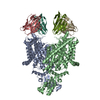
|
|---|---|
| 1 |
|
- Components
Components
| #1: Protein | Mass: 73521.484 Da / Num. of mol.: 2 / Mutation: N373Q Source method: isolated from a genetically manipulated source Source: (gene. exp.)   Homo sapiens (human) / References: UniProt: E1B792 Homo sapiens (human) / References: UniProt: E1B792#2: Antibody | Mass: 11824.102 Da / Num. of mol.: 2 Source method: isolated from a genetically manipulated source Source: (gene. exp.)   #3: Antibody | Mass: 12633.068 Da / Num. of mol.: 2 Source method: isolated from a genetically manipulated source Source: (gene. exp.)   Has protein modification | Y | |
|---|
-Experimental details
-Experiment
| Experiment | Method: ELECTRON MICROSCOPY |
|---|---|
| EM experiment | Aggregation state: PARTICLE / 3D reconstruction method: single particle reconstruction |
- Sample preparation
Sample preparation
| Component | Name: A bovine CLC-K channel complexed with a monoclonal antibody fragment (Fab) Type: COMPLEX Details: Fab fragment generated by proteolytic (papain) cleavage of murine IgG antibody. Entity ID: all / Source: RECOMBINANT | ||||||||||||||||||||||||||||||
|---|---|---|---|---|---|---|---|---|---|---|---|---|---|---|---|---|---|---|---|---|---|---|---|---|---|---|---|---|---|---|---|
| Molecular weight | Experimental value: NO | ||||||||||||||||||||||||||||||
| Source (natural) | Organism:  | ||||||||||||||||||||||||||||||
| Source (recombinant) | Organism:  Homo sapiens (human) / Plasmid: pFastBac (BacMam) Homo sapiens (human) / Plasmid: pFastBac (BacMam) | ||||||||||||||||||||||||||||||
| Buffer solution | pH: 7.5 | ||||||||||||||||||||||||||||||
| Buffer component |
| ||||||||||||||||||||||||||||||
| Specimen | Conc.: 3 mg/ml / Embedding applied: NO / Shadowing applied: NO / Staining applied: NO / Vitrification applied: YES | ||||||||||||||||||||||||||||||
| Specimen support | Grid material: COPPER / Grid type: Quantifoil R1.2/1.3 | ||||||||||||||||||||||||||||||
| Vitrification | Instrument: FEI VITROBOT MARK IV / Cryogen name: ETHANE / Humidity: 90 % / Chamber temperature: 295 K |
- Electron microscopy imaging
Electron microscopy imaging
| Experimental equipment |  Model: Titan Krios / Image courtesy: FEI Company |
|---|---|
| Microscopy | Model: FEI TITAN KRIOS |
| Electron gun | Electron source:  FIELD EMISSION GUN / Accelerating voltage: 300 kV / Illumination mode: FLOOD BEAM FIELD EMISSION GUN / Accelerating voltage: 300 kV / Illumination mode: FLOOD BEAM |
| Electron lens | Mode: BRIGHT FIELD |
| Image recording | Average exposure time: 0.3 sec. / Electron dose: 1.8 e/Å2 / Detector mode: SUPER-RESOLUTION / Film or detector model: GATAN K2 SUMMIT (4k x 4k) |
- Processing
Processing
| Software | Name: REFMAC / Version: 5.8.0088 / Classification: refinement | ||||||||||||||||||||||||||||||||||||
|---|---|---|---|---|---|---|---|---|---|---|---|---|---|---|---|---|---|---|---|---|---|---|---|---|---|---|---|---|---|---|---|---|---|---|---|---|---|
| EM software |
| ||||||||||||||||||||||||||||||||||||
| CTF correction | Type: PHASE FLIPPING AND AMPLITUDE CORRECTION | ||||||||||||||||||||||||||||||||||||
| Symmetry | Point symmetry: C2 (2 fold cyclic) | ||||||||||||||||||||||||||||||||||||
| 3D reconstruction | Resolution: 3.76 Å / Resolution method: FSC 0.143 CUT-OFF / Num. of particles: 82167 Details: the indicated resolution was estimated on the primary map using the provided mask including Fab. Symmetry type: POINT |
 Movie
Movie Controller
Controller


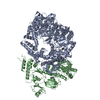
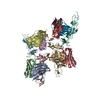

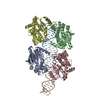
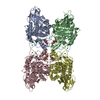
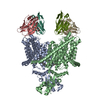
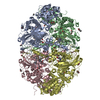
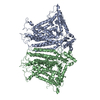
 PDBj
PDBj

